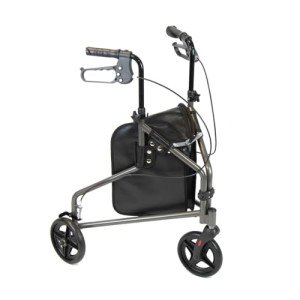
Rollator With Storage
Overview
-
Sectors Service
Company Description
If You’ve Just Purchased Mobility Aid … Now What?
Understanding Mobility Aids: Enhancing Independence and Quality of Life
Mobility aids are vital tools that assist people with physical disabilities or conditions that hinder their ability to move easily. These aids not just promote independence and improve quality of life however likewise provide safety and assistance for users in numerous environments. The landscape of mobility aids is broad, incorporating a variety of gadgets tailored to fulfill individual requirements. This post aims to explore the different types of mobility aids, their benefits, considerations for use, and regularly asked questions.
Types of Mobility Aids
Mobility aids can be categorized into several major types, each developed to help in particular methods. Below is a table summarizing the most typical mobility aids:

| Type of Mobility Aid | Description | Perfect Use Case |
|---|---|---|
| Wheelchairs | A chair installed on wheels used by those not able to walk. | Long-term disability or serious mobility problems. |
| Walkers | A frame that provides assistance for individuals while walking. | Post-surgery healing or balance problems. |
| Walking sticks | A stick utilized for balance and support while walking. | Mild mobility issues or as a preventive procedure. |
| Rollators | A walker equipped with wheels and typically a seat. | People needing support over longer ranges. |
| Crutches | Devices used to elevate and support the body weight of a person with a leg injury. | Momentary injuries requiring non-weight bearing. |
| Scooters | A motorized gadget for those who can sit however not walk cross countries. | Long trips and fatigue-prone individuals. |
| Lift Chairs | Reclining chairs that raise to help users in standing. | Elderly individuals or those with extreme pain. |
Benefits of Mobility Aids
Making use of mobility aids extends beyond simple transport; they serve numerous crucial functions in boosting the well-being of users:
- Independence: Mobility aids empower users to perform day-to-day activities without relying heavily on caregivers or help from others.
- Safety: Many mobility aids are developed to reduce the threat of falls, providing users with stability when moving.
- Improved Quality of Life: By enhancing mobility, people can participate in social activities, workout, and preserve community connections, positively impacting their mental health.
- Access to Environments: Mobility aids can assist in access to locations that might otherwise be challenging to navigate, such as public transport and public spaces.
- Assistance Recovery: They play a vital function in rehab following surgical treatment or injury by promoting steady mobility and aiding recovery.
Considerations for Choosing the Right Mobility Aid
Selecting the suitable mobility aid can substantially affect an individual’s quality of life. Here are numerous essential factors to consider to remember:

- Level of Mobility Impairment: Assess the seriousness of mobility issues to determine the most appropriate type of aid.
- User’s Physical Condition: Consider aspects like weight, strength, and total health.
- User’s Lifestyle and Environment: Analyze where the mobility aid will be used usually: inside, outdoors, or both.
- Functional Needs: Evaluate if additional features such as storage, seating, or height adjustments are essential.
- Consultation with Professionals: Always seek guidance from healthcare experts for guidance customized to specific scenarios.
Frequently Asked Questions (FAQs)
Q1: What is the difference between a walker and a rollator?A1: A walker is a basic frameused for support and balance, while a rollator has wheels, offering simpler mobility and frequently features additional features such as a seat and storage. Q2: Can mobility aids be covered by insurance?A2:
Many medical insurance plans, consisting of Medicare, may cover mobility aids if they are deemed clinically required. It is a good idea to talk to your insurance service provider for specific details. Q3: How do I understand when it’s time to use a mobility aid?A3: If you’ve experienced frequent falls, relentless discomfort
while walking, or have difficulty finishing daily activities
, it might be time to consider a mobility aid. Consult a health care professional for individualized recommendations. Q4: Are there mobility aids created for outdoor use?A4: Yes, many mobility aids are particularly created for outdoor environments, including scooters, Outdoor Walker walkers, and all-terrain wheelchairs, equipped to deal with various terrains. Q5: Can I use a mobility aid after surgery, like knee replacement?A5: Yes, mobility aids such as walkers and crutches are typically advised post-surgery to aid recovery and preserve safety as you regain
strength. Mobility aids play an important function in supporting individuals with mobilitychallenges, facilitating independence, and boosting overall lifestyle. With a varied series of choices readily available, it’s vital for users to evaluate their unique needs and seek advice from with professionals to select the most suitable aid. As innovation and style continue to progress, these aids will undoubtedly become a lot more user-friendly and efficient, promoting a more inclusive world for everyone. By understanding the various kinds of mobility aids and their respective benefits, individuals can make educated options that improve their mobility and facilitate a more active and satisfying way of life.

